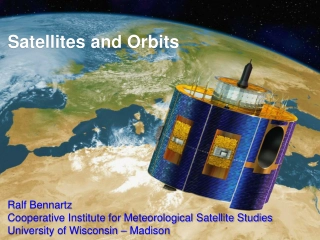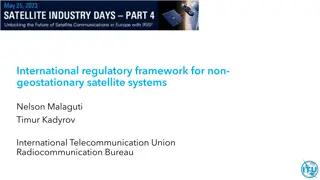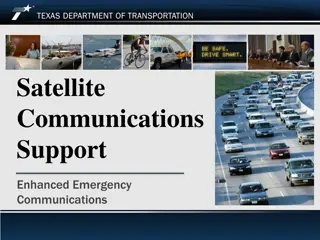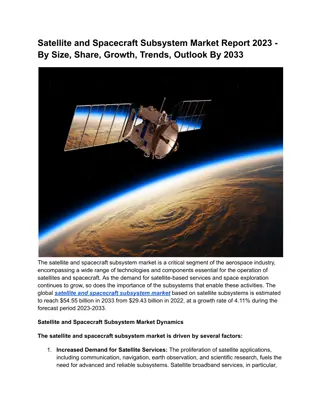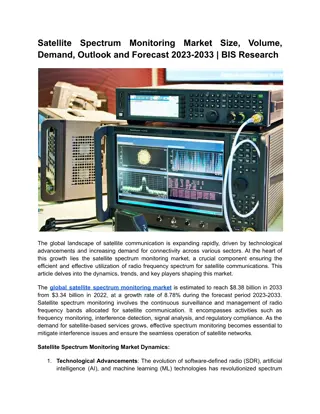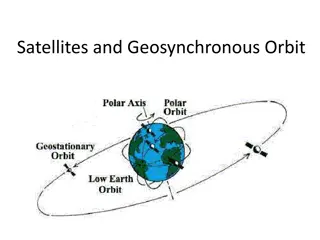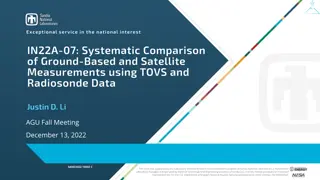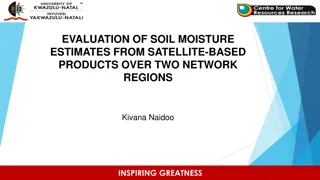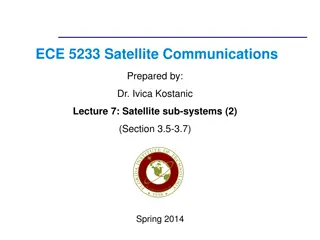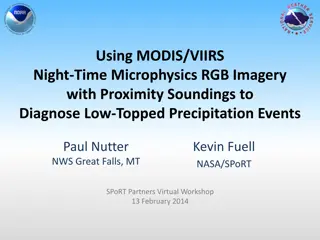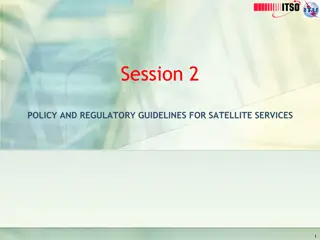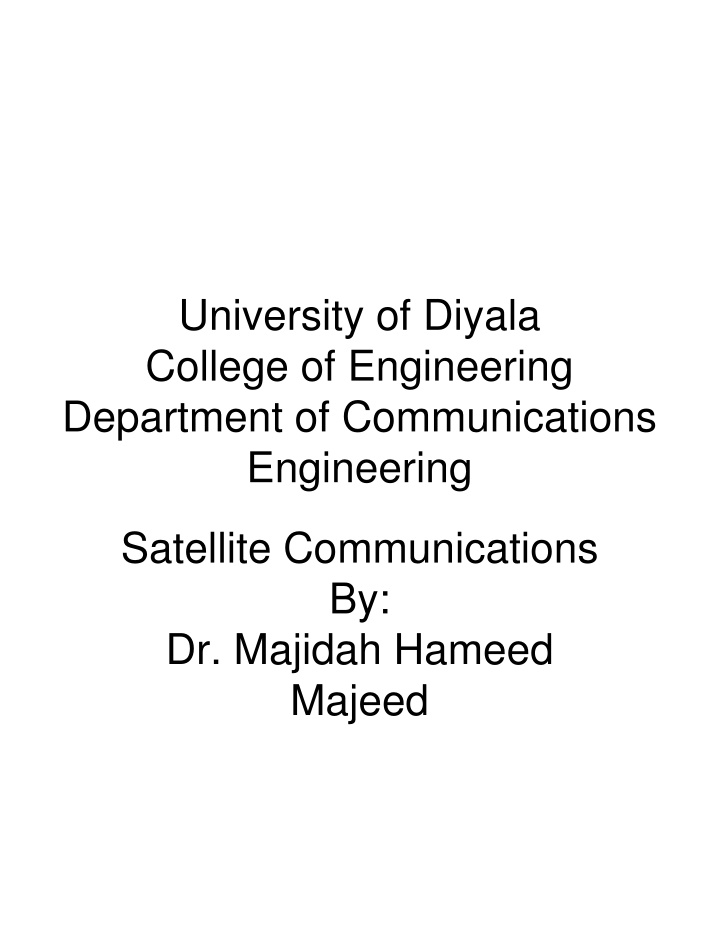
Noise Considerations in Satellite Communications Engineering Lectures
Explore the fundamentals of noise considerations in satellite communication links, covering external and internal noise sources, thermal noise, signal-to-noise ratio, and various losses affecting satellite communication systems.
Download Presentation

Please find below an Image/Link to download the presentation.
The content on the website is provided AS IS for your information and personal use only. It may not be sold, licensed, or shared on other websites without obtaining consent from the author. If you encounter any issues during the download, it is possible that the publisher has removed the file from their server.
You are allowed to download the files provided on this website for personal or commercial use, subject to the condition that they are used lawfully. All files are the property of their respective owners.
The content on the website is provided AS IS for your information and personal use only. It may not be sold, licensed, or shared on other websites without obtaining consent from the author.
E N D
Presentation Transcript
University of Diyala College of Engineering Department of Communications Engineering Satellite Communications By: Dr. Majidah Hameed Majeed
2.6 Noise Considerations in Satellite Comm. Link Noise can be described as any unwanted electrical signal, it can be divide to: a. External noise, it caused by noise source outside the electronic circuits used in the system. b. Internal noise , is electrical noise that is generated inside the resistors, transistor , diodes used in amplifier , mixer detectors , .etc. this noise called thermal noise . Fig 2.2 Noise (1): Noise included in signal source plus thermal noise generated by modulator, frequency converter, and power amplifier. In most cases, this noise is sufficiently small compared to signal power and is negligible compared with other noise sources.
Noise (2): Thermal noise from ground received by satellite antenna (often at 300K). Noise (3): Thermal noise generated by the satellite transponder and governed by the low-noise performance of the transponder s first stage. Noise (4): Noise received by the ground antenna in addition to the signal from the satellite; includes sky noise, atmospheric thermal noise, and terrestrial thermal noise. Noise (5): Thermal noise generated by the ground receiver and governed by the low noise performance of the first-stage amplifier. Example ; A satellite link operating at 14 GHz has receiver feeder losses of1.5 dB and a free-space loss of 207 dB. The atmospheric absorption loss is 0.5 dB, and the antenna pointing loss is 0.5 dB. Depolarization losses may be neglected. Calculate the total link loss for clear-sky conditions. Solution The total link loss is the sum of all the losses: 2.7 equivalent input noise temperatures
Fig (2.3) 2.7.1 Thermal Noise power ? Thermal noise power ( ) generated by resistance at T, ?= k Ts B (in watts). k - Boltzmann s Constant, = 1.38 10 23 J/K; Ts - noise temperature. is in Kelvin, B is in Hz. The noise power per unit bandwidth is termed the noise power spectral density. Denoting this by No, then No = PN / BN = K Ts Example Given Te = 120 K , gain = 50 dB, frequency = 3.7 GHz to 4.2 GHz Find the internal noise power Solution
?= k Te B Bandwidth = f2 f1 = 4.2 3.7 = 0.5 GHz Pn = 1.38 * 10 23 * 120 * 0.5 109 8.28 * 10 13 w 2.7.2 Signal to noise ration SNR The quality of electrical signals is generally described by the ratio of signal power to noise power SNR =??and in decibel ?? SNR = 10 Log ps / pn Example : A particular receiver has 0.42 pico w of noise at the input , determine the minimum input signal needed to obtain a 45 dB SNR . Solution SNR =??and in decibel ?? SNR = 10 Log ps / pn 45 = 10 Log ps / 0.42 * 10 12 4.5 = Log ps -12 Log 4.2 Log ps = 13.28 nw Example : input output Given : psin pout Input signal = psin = 10 * 10 10 w External noise = pn1 = 1.12 * 10 13 w Amplifier gain G = 1000
Amplifier BW= B= 27 * 106Hz Internal amplifier noise = pn2 = 1* 10 13w Find : 1. Input signal to noise ratio SNR 2. Output signal pout , 3. output noise , 4. output signal to noise ratio Solution . = ?w 1. SNR = 10 Log psin / pn1 = 10 Log = 29.51 dB 2. Pout = G psin = 1000 * 1 10 10 3. Output noise = ( pn1 + pn2 ) * G = ( 1 10 10 + 1.12 10 13 ) * 1000 = 2.12 * 10 10W ? 4. O/P SNR = 10 Log = 10 Log = 26.74 dB ? ? . 2.7.3 Noise figure ( NF) From the following fig Ta G Rx Ni No Te Sin / Ni = Sin / KTa B Sout / Nout = G Sin / G Ts B
Where Ts = Ta + Te Also noise figure can be written in term of noise temperature, Te . Then Te = To(NF-1) To , is the reference temperature used to calculate the standard noise figure ? usually =290 Example Then Teff = To( F -1 ) , noise figure must be in linear , 2.7 dB = 1.86 ? , k its kelven degree Teff = 290 ( 1.86 -1 ) = 250 Example An antenna has a noise temperature of 35 K and is matched into a receiver which has a noise temperature of 100 K. Calculate (a) the noise power density and (b) the noise power for a bandwidth of 36 MHz. Solution
Example An LNA is connected to a receiver which has a noise figure of 12 dB. The gain of the LNA is 40 dB, and its noise temperature is 120 K. Calculate the overall noise temperature referred to the LNA input. Solution 12 dB is a power ratio of 15.85:1, and therefore, 2.8 Calculation of System Noise Temperature Consider first the noise representation of the antenna and the low noise amplifier (LNA) as shown in Fig. 2.4 a. The available power gain of the amplifier is denoted as G, and the noise power output, as No,out
For the moment we will work with the noise power per unit bandwidth, . Fig(2.4) The input noise energy coming from the antenna is Where K is a degree kelvin not thousand The output noise energy No,out will be G ?0,??? plus the contribution made by the amplifier. Now all the amplifier noise, wherever it occurs in the amplifier, may be referred to the input in terms of an equivalent input noise temperature for the amplifier Te This allows the output noise to be written as
The cascade connection is shown in Fig. 2.4 b. For this arrangement, the overall gain is The noise energy of amplifier 2 referred to its own input is simply kTe2 The noise input to amplifier 2 from the preceding stages is G1k (Tant + Te1 ), and thus the total noise energy referred to amplifier 2 input is This noise energy may be referred to amplifier 1 input by dividing by the available power gain of amplifier 1: This is a very important result. It shows that the noise temperature of the second stage is divided by the power gain of the first stage when referred to the input. Therefore, in order to keep the overall system noise as low as possible, the first stage (usually an LNA) should have high power gain as well as low noise temperature This result may be generalized to any number of stages in cascade, giving
Example 2.9 Carrier-to-Noise Ratio A measure of the performance of a satellite link is the ratio of carrier power to noise power at the receiver input, and link-budget calculations are often concerned with determining this ratio. Conventionally, the ratio is denoted by C/N (or CNR), which is equivalent to PR/PN. In terms of decibels, C/N = Pr - PN C = Pr = carrier receiving power Pr = Pt Gt Gr / LF EIRP = Pt Gt N = k Ts B Then
Pt 1 C/N = .Gr . Gt ?? ? LF In dB Noise Density It is a power presented at 1 KHz bandwidth, The ratio of carrier power to noise power density may be the quantity actually required then
[C/N] is a true power ratio in units of decibels, and [BN] is in decibels relative to one hertz, or dBHz. Thus the units for [C/No] are dB Hz. Substituting Eq (3.33) for [C/N] gives 2.10 Figure of merit ( G / T Ratio for Earth Station ) This ratio is widely used to specify the quality of an earth station & sat. The antenna gain Gd and the system noise temperature TS can be combined in Eq Therefore the link equation becomes Example Calculate the overall C/N for a satellite link with the following parameters: Satellite s EIRP: 45 dBW; Downlink free-space loss: 205.4 dB (12 GHz); Uplink noise contribution: 0.5 dB; Additional losses: 0.5 dB; Receiver ground terminal bandwidth: 20 MHz; Receiver ground terminal (G/T): 20 dB/K.
Solution. The receiver ground terminal bandwidth, expressed in decibels, is Example Consider a satellite transmitting 25W at a frequency of 4 GHz via an antenna of 18dB gain. An earth station in the network uses an antenna of 12m diameter with an efficiency of 65%. Assuming the satellite-earth station range to be 40 000 km. Determine: 1- The gain of the earth station antenna. 2- The path loss (FSL). 3The flux density at the earth station. 4The power received at the output of the earth station antenna. Ans
Example : GEO satellite system having received power of 50 pw from

